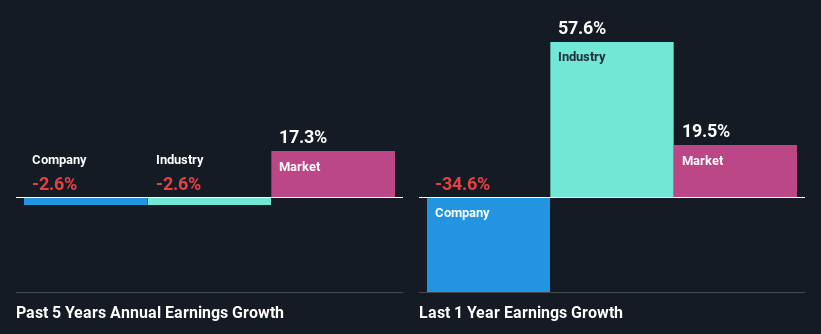Does C-Com Satellite Systems Inc.'s (CVE:CMI) Weak Fundamentals Mean That The Market Could Correct Its Share Price?
Most readers would already be aware that C-Com Satellite Systems' (CVE:CMI) stock increased significantly by 10% over the past three months. We, however wanted to have a closer look at its key financial indicators as the markets usually pay for long-term fundamentals, and in this case, they don't look very promising. Particularly, we will be paying attention to C-Com Satellite Systems' ROE today.
Return on equity or ROE is an important factor to be considered by a shareholder because it tells them how effectively their capital is being reinvested. In simpler terms, it measures the profitability of a company in relation to shareholder's equity.
Check out our latest analysis for C-Com Satellite Systems
How Is ROE Calculated?
The formula for ROE is:
Return on Equity = Net Profit (from continuing operations) ÷ Shareholders' Equity
So, based on the above formula, the ROE for C-Com Satellite Systems is:
4.4% = CA$1.1m ÷ CA$25m (Based on the trailing twelve months to May 2022).
The 'return' is the yearly profit. One way to conceptualize this is that for each CA$1 of shareholders' capital it has, the company made CA$0.04 in profit.
What Has ROE Got To Do With Earnings Growth?
So far, we've learned that ROE is a measure of a company's profitability. Depending on how much of these profits the company reinvests or "retains", and how effectively it does so, we are then able to assess a company’s earnings growth potential. Generally speaking, other things being equal, firms with a high return on equity and profit retention, have a higher growth rate than firms that don’t share these attributes.
C-Com Satellite Systems' Earnings Growth And 4.4% ROE
On the face of it, C-Com Satellite Systems' ROE is not much to talk about. We then compared the company's ROE to the broader industry and were disappointed to see that the ROE is lower than the industry average of 8.8%. Given the circumstances, the significant decline in net income by 2.6% seen by C-Com Satellite Systems over the last five years is not surprising. However, there could also be other factors causing the earnings to decline. For instance, the company has a very high payout ratio, or is faced with competitive pressures.
With the industry earnings declining at a rate of 2.6% in the same period, we deduce that both the company and the industry are shrinking at the same rate.
Earnings growth is an important metric to consider when valuing a stock. It’s important for an investor to know whether the market has priced in the company's expected earnings growth (or decline). Doing so will help them establish if the stock's future looks promising or ominous. Has the market priced in the future outlook for CMI? You can find out in our latest intrinsic value infographic research report
Is C-Com Satellite Systems Using Its Retained Earnings Effectively?
C-Com Satellite Systems' high three-year median payout ratio of 115% suggests that the company is depleting its resources to keep up its dividend payments, and this shows in its shrinking earnings. Paying a dividend higher than reported profits is not a sustainable move. Our risks dashboard should have the 7 risks we have identified for C-Com Satellite Systems.
In addition, C-Com Satellite Systems has been paying dividends over a period of at least ten years suggesting that keeping up dividend payments is way more important to the management even if it comes at the cost of business growth.
Summary
Overall, we would be extremely cautious before making any decision on C-Com Satellite Systems. Particularly, its ROE is a huge disappointment, not to mention its lack of proper reinvestment into the business. As a result its earnings growth has also been quite disappointing. So far, we've only made a quick discussion around the company's earnings growth. So it may be worth checking this free detailed graph of C-Com Satellite Systems' past earnings, as well as revenue and cash flows to get a deeper insight into the company's performance.
Have feedback on this article? Concerned about the content? Get in touch with us directly. Alternatively, email editorial-team (at) simplywallst.com.
This article by Simply Wall St is general in nature. We provide commentary based on historical data and analyst forecasts only using an unbiased methodology and our articles are not intended to be financial advice. It does not constitute a recommendation to buy or sell any stock, and does not take account of your objectives, or your financial situation. We aim to bring you long-term focused analysis driven by fundamental data. Note that our analysis may not factor in the latest price-sensitive company announcements or qualitative material. Simply Wall St has no position in any stocks mentioned.
Join A Paid User Research Session
You’ll receive a US$30 Amazon Gift card for 1 hour of your time while helping us build better investing tools for the individual investors like yourself. Sign up here

 Yahoo Finance
Yahoo Finance 
